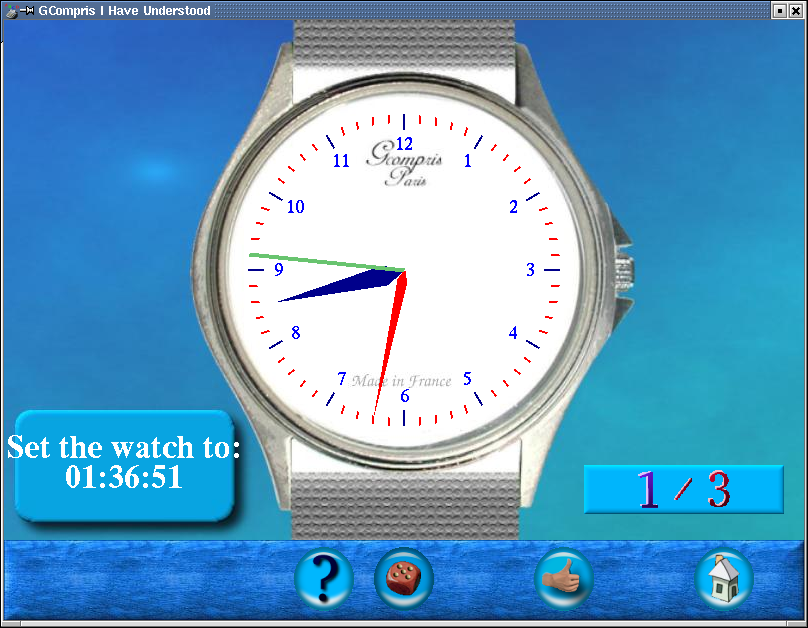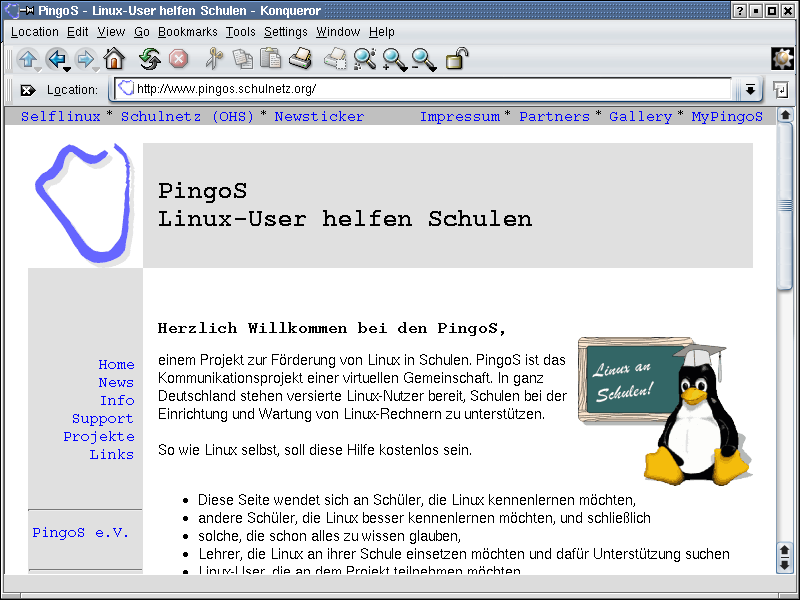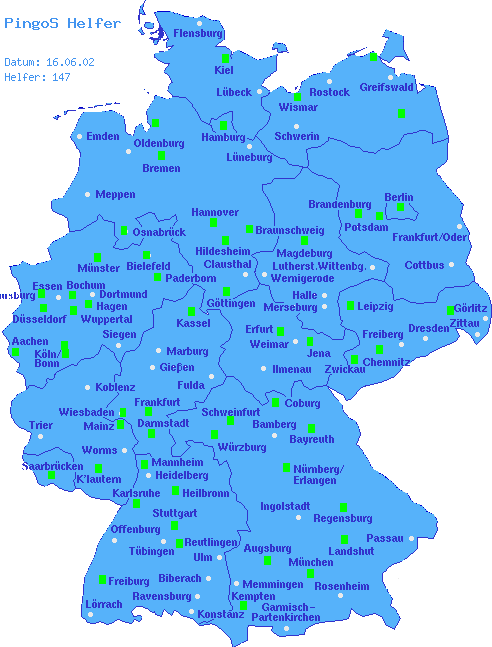TUX&GNU@school - 2nd edition
Every month the column TUX&GNU@school reports about free education software, a homepage on the topic and an easy to implement idea. This month I talk about GCompris, a GNU education program for the young and the old, about PingoS.schulnetz.org, a homepage for GNU/Linux support at german schools and about the idea "Text4mator - text modification made easy".
Welcome to the second edition of TUX&GNU@school [18]. At the beginning I want to thank all the people who sent me tips for education software I could report about. At this place it would be good to explain this column's name: TUX is the name of the meanwhile well-known mascot of Linux, a little dinky penguin. But GNU [2] on the one hand stands for the recursive acronym "GNU is not UNIX", which is the name of a project that's developing a free version of UNIX and on the other hand it stands for the animal species of the mascot of GNU. Finally the "@school" means "in or at school". But now we're going on to the first item.
GCompris - free education software for the young and the old
GCompris [3] is a free education program that has become official GNU software in the meantime. Actually it's more a uniform interface for different learning boards. I tested the version 1.0.5 under Debian GNU/Linux 3.0 (testing) and KDE 2.2.
When you start the program, the main window of screenshot 1 appears. This window is split in three sections with the single learning boards at the top, a short description in the middle and a short menu panel at the bottom. Up to now there are at the head four links that are guiding to another boards and under it, in the second row, there are four boards guiding to the following boards: With the first one, the kid can learn the clock or time, the second link goes to a simple vector painting programm, at the third board you have to set the watergates that way TUX with his ship can go trough and eventually the child learns with the fourth board, where the different countries are situated in North and South America. The pictures at the head of the main window are indicated by different symbols. The small yellow arrow tells the link is going to additional teaching boards, whereas the little stars, at the pictures which are boards themselves, show the level. At teaching boards with an integrated sound output the loudspeaker symbol tells you, if sound output is possible or not, like it's the case in screenshot 1. You can always read a short description and the name of the author in the middle part of the main window. And eventually at the bottom there are four symbols which, from left to right, go to more information about GCompris, open the configuration menu, show the helping documentation and with a click on the last picture closes the program. At the configuration menu you can make settings like the language you prefer or if GCompris has his own window or it starts in fullscreen mode. Regarding the language settings, you should adapt the environment variable LANG to match your language. If not, you can change it e.g. for english by writing the following command on a console: export LANG=en_EN.

Screenshot 1: GCompris in action
With the board for learning the time, I want to show how the single subprograms are built. As you can see in screenshot 2, there is a menu at the bottom too, which contains little pictures. By clicking on the picture rightmost you go back to the main window. By the other two the picture with the die shows you the current level und by clicking on it you climb one level. If you are content with your settings, push the hand with thumb up or alternatively you can push RETURN and the computer checks the correctness of the settings. If the answer was correct you see either a happily clown face or a flower with a laughing mouth and you can even hear it with activated sound output; if the result was wrong, the clown and the flower are sad and you can try it again. The problem you have to solve in this board is to set the watch as the text at the left says. The watch hands can be moved and set with the mouse. In higher levels even the hour watch hand are set to the time given by the minute hand watch. At the right you can see in which of how many levels you are, shown by to numbers.

Screenshot 2: Learning the time with GCompris
As already said at the beginning GCompris is supposed to be "only" a common interface for different teaching boards. The developer encourages everyone to build own boards as descriped shortly in the documentation. Personally I like this program very much because it is interesting for every age with his different subprograms. Up to now GCompris was translated into German, English, French and Spanish whereas they work on an Italian translation and for the near future we can expect a Hungarian one. What I still miss is a evaluation or something like highscores but I think that we won't wait as long for these features because the development of GCompris is going very quickly. Therefore a great thank you for Bruno Coudoin and all the other authors of GCompris too and a lot of success for the future.
Addendum: As I saw right now on the mailing list of the project, they released GCompris 1.1.0. The first edition with editor functions and a Hungarian translation.
But now to the home of the PingoS.
Pingos.schulnetz.org - free support for free schools
Attention: This site is available in German only !!!
Under the URL above you find in the first place the head quarter [4] (see screenshot 2) of the German PingoS. That's a project which wants to find and coordinate volunteers in (at the moment) Germany for GNU/Linux support at schools. They try this with the help of different online media. Willing and interested GNU/Linux appreciators can sign in the online form [5] which asks for state of knowledge and residence too. All data exclusive the name, the email address and the residence are used only internally, the others are entered in the PingoS-helper-card (see screenshot 4). Schools in Germany searching help for imminent project or that only have questions on topic can search on the helper-card [6] and click on the nearest town for a list of helpers in that area. If you only have questions sometimes it's surely not a bad idea to subscribe on the mailing list [7] of the preject. There are always able and rapid answers on the main list [8]. If think about larger projects or questions, they distribute the responsibility for it on one of the mailing lists. The work is mostly documented with a short description on the project website [9]. For the future interesting is surely the corporation with groups of Austria or the "ALIS - Arbeitsgruppe Linux an Schulen" [10] (Swiss work group for Linux at school) of Switzerland. Particularly you can even hear about requests from Great Britain for building up something similar.

Screenshot 3: Front page of the Pingos homepage
But the support project isn't the only that's at home on the homepage of the PingoS. Not forgetting the section with the self-developed software [11] of the PingoS, e.g. education or administration software. One of the most famous projects surely is the "Tipptrainer" [12], another program for learning typing, but more about it at another time. Furthermore you can find there a lot of small scripts [13], Perl or Bash, which ease the day for us. A last section of the website I want to talk about is the area with the documentation and the schooling brochures [14]. There you can find almost everything from Python introductions to medium large GNU/Linux courses.

Screenshot 4: PingoS helper card
At the end I still want to tell about a very interesting project of the PingoS: SelfLinux [15]. With SelfLinux the PingoS want to create a complete reference to GNU/Linux for novices. Therefor they collect written descriptions and articles about tasks and problems around the free operating system and the application software and compose them structured. Until now there is already a lot of knowledge and texts but they still need writer for another texts. At [16] you can explore the work made up to now. From my side good speed for the future and may you receive a "thank you" from time to time.
That's it about the PingoS, let's proceed to a new idea for an easy to implement software.
Text4mator - text modification made easy
Before I talk about the idea of this month, I still want to write something about the last one and what resulted of it. In the first three or four months after the publication of the first edition it seemed as if nobody had time to implement the idea. Therefor and because I had to learn programming for my studies I tried it myself. I wrote a not yet satisfying program in C++ that generates random numbers through a bash script that the program writes to a file with LaTeX formatting. The two commands latex and dvips transform this file into an Postscript file which is printed by lpr. I'll release the program and a short description in a few days on [10] under the terms of the GNU GPL. At this point still a thank you to Diego Kuonen for his help with the LaTeX syntax. Then before approximately one and a half month I received an email form Franziska Meyer that she implemented the idea too. But she made it by far more interesting. Because she was already familiarising herself with PHP at that time, she had the idea to implement it as a web service (I want to use this new word once too ;-). Thought and done and like this it is possible today going on her website [17] to generate a worksheet which is downloadable as a pdf-file for the quarter of an hour. An ingenious idea as I think; because like this you don't even have to install a separate program. When I asked her to release the source code to install it perhaps in an Intranet she said: "Ok, ich überleg's mir mal - und schaue den Code durch, ob ich den wirklich freigeben kann ;-)" (Ok, I think about it - and will go through the code whether I can really release that ;-)). Here too a great thank you to ZIS for her effort.
But now up to the actually idea I want to introduce this time. If you learn the verbosity at school you're doing it right often with worksheets with upper-case texts. In the other case you use for the introduction of punctuation marks often texts without periods, commas, questions marks, etc. The teachers make this all in toilsome handwork. On the other case it would be right easy for good script writers and programmers to implement a solution. There were again different variations and possibilities, e.g. to write all words upper- or lower-case, to write only the first letter lower- or upper-case, etc. Furthermore you have to pay attention to leave always the same space between the single words. I hope somebody of you is having a good mind and I can report about it next time.
Ok, that's the end for this time. At the end I let you know that my (spontaneous) conceptions for easy to implement ideas are becoming quite rare. I hope so that you can help in this case and will send some to me [1] I can tell about. The next time is already in two weeks because this edition came too late and I don't want to begin with delays. Bye up to the next time when we're on it again ...
Links:
[1] Criticism, questions,
comments, ideas and more please to: foxman@lugo.ch
[2] Homepage of the GNU
project: www.gnu.org
[3] Homepage of
GCompris: www.ofset.org/gcompris
[4] Homepage of
the PingoS: www.pingos.schulnetz.org
[5] Registration
to the PingoS:
www.pingos.schulnetz.org/anmeldung.php
[6] Helper-card
of the PingoS:
www.pingos.schulnetz.org/support/map.php
[7]
Mailing lists of the PingoS:
www.pingos.schulnetz.org/support/mailinglist/index.php
[8] Main
list of the PingoS:
www.hh.schule.de/mailman/listinfo/all-linux
[9]
Already finished projects of the PingoS:
www.pingos.schulnetz.org/support/projektliste.php
[10] Homepage of "ALIS -
Arbeitsgruppe Linux an Schulen" (Swiss work group for linux
at school): www.edux.ch
[11]
Software of the PingoS:
www.pingos.schulnetz.org/project/software/index.php
[12] Homepage
of Tipptrainer:
www.pingos.schulnetz.org/tipptrainer
[13]
Skript collection of thePingoS:
www.pingos.schulnetz.org/project/scripts/index.php
[14]
Documentation and schooling brochures of the PingoS:
www.pingos.schulnetz.org/project/schulung/index.php
[15] Sourceforge.net page
of SelfLinux: selflinux.sourceforge.net
[16] Homepage of
SelfLinux: www.selflinux.de
[17] 1x1
worksheets generating online and downloading:
www.atreju.ch/1mal1.phtml
[18] Homepage
of TUX&GNU@school:
fsfe.org/activities/tgs/tgs.en.html
About the author:
Mario Fux finished 1999 the PrimarlehrerInnenseminar in Brig after he made up mathematical and natural scientifical matura. In a body with two colleagues he founded the "ALIS - Arbeitsgruppe Linux an Schulen" (Swiss work group for linux at school). Meanwhile he studies at the Swiss Federal Institut of Technology Zurich informations technology and electrical engineering. And if he once doesn't spend his time in front of the PC, he sits at his nature pond in the mountains.
Copyright (c) 2002 Mario Fux. Permission
is granted to copy, distribute and/or modify this document
under the terms of the GNU Free Documentation License, Version
1.2 or any later version published by the Free Software
Foundation; with no Invariant Sections, no Front-Cover Texts,
and no Back-Cover Texts.
A copy of the license can be found at http://www.gnu.org/licenses/fdl.html.